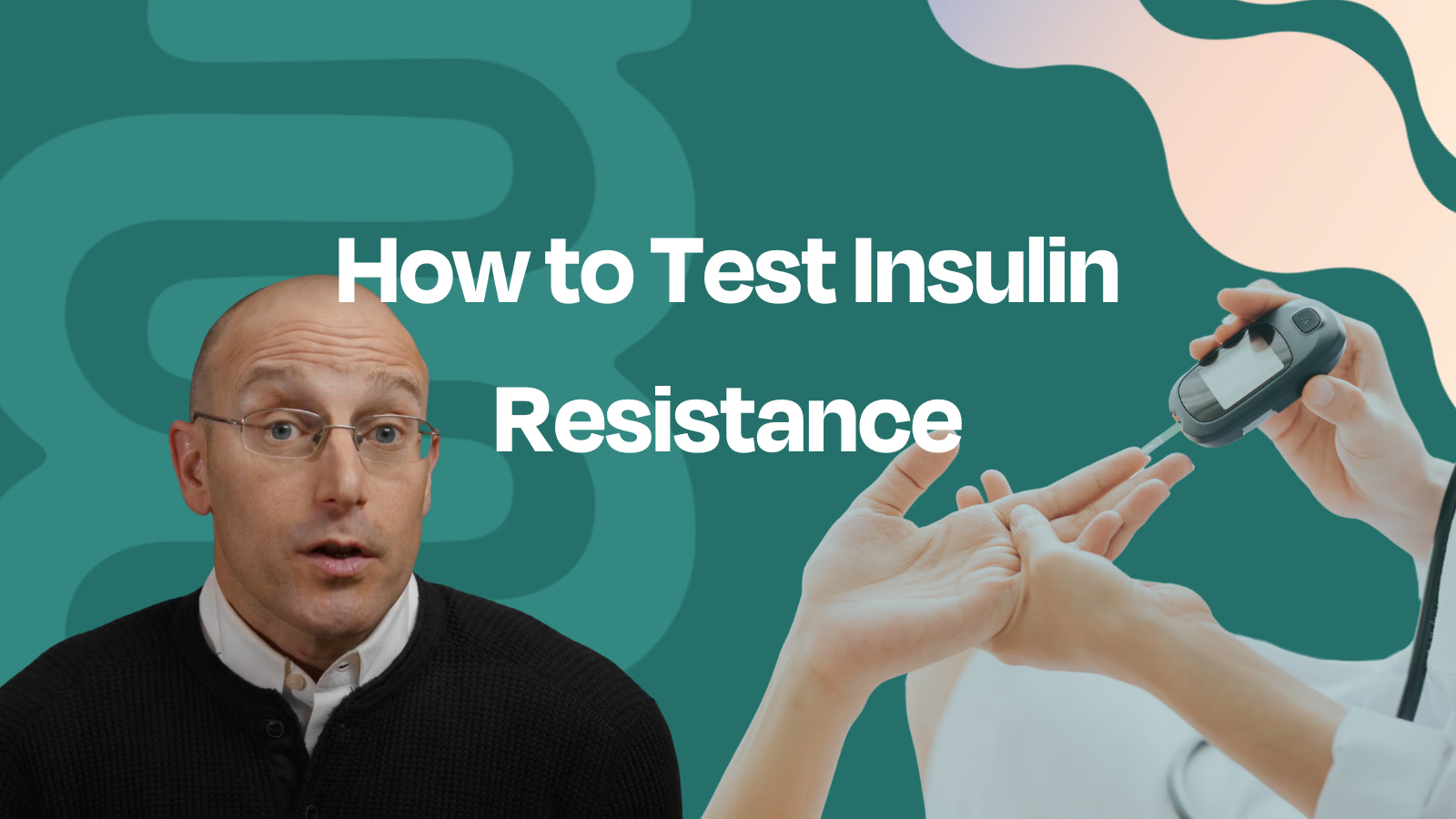Read this article to learn what insulin resistance is and how to test for it.
Testing for Insulin Resistance For Mental Health
Insulin resistance has long been associated with metabolic health conditions, including type-2 diabetes, obesity, and cardiovascular disease.
But did you know insulin resistance may also affect your mental health?
In this article, we’ll delve into the intricate connection between insulin resistance and mental health. We will discuss what insulin resistance is and what the evidence says about how insulin resistance affects your mental state. We’ll also explore how to easily test for insulin resistance so you can know if you’re at risk.
What Is Insulin Resistance?
To understand insulin resistance, you first have to understand insulin.
Insulin is a hormone produced by the pancreas in response to consuming nutrients, mostly carbohydrates. Once in your bloodstream, insulin takes some of the circulating glucose and transports it into your cells. Once inside the cell, that glucose can be used for energy.
But when insulin gets released too often, the body progressively stops responding to it as well and becomes resistant to its presence. In this circumstance, insulin and blood glucose levels both start to rise.
This state of high blood glucose and high insulin is called insulin resistance.
Insulin resistance, also known as metabolic dysfunction, is a precursor to metabolic syndrome, prediabetes, and type 2 diabetes. It increases your risk for cardiovascular disease as well as potentially for dementia or even cancer.
What’s especially relevant for us at Metabolic Mind is that insulin resistance often coexists with symptoms of mental illness. If you have symptoms of a mental disorder, it would be wise to check with your doctor about your degree of insulin resistance.
Testing for Insulin Resistance: HOMA-IR
Traditionally, metabolic dysfunction isn’t diagnosed until someone has metabolic syndrome. This shows up as increased triglycerides, fasting glucose, waist circumference, and blood pressure, as well as decreased HDL levels.
Those who develop metabolic syndrome are at risk for multiple medical complications. Unfortunately, by the time people are diagnosed with metabolic syndrome, insulin resistance may have been going on for years.
But you can do something to prevent the long-term damage caused by insulin resistance: test for it early and in an accurate and accessible way.
That’s why the first test we recommend for insulin resistance is a HOMA-IR, or a “homeostatic model assessment for insulin resistance.” This is a simple blood test that measures your body’s ability to use insulin effectively. All you need is a fasting glucose and insulin level.
If your result on this test is less than 1, that suggests you don’t have insulin resistance. If your result is greater than 1.9, it’s likely you have insulin resistance. Any result greater than 2.9 implies severe insulin resistance.
Here’s an example of how it works:
Let’s say you have a fasting glucose of 95 and a fasting insulin level of 3. In this case, your HOMA-IR is 0.7, which is excellent. It shows that you are insulin sensitive and your body uses insulin well.
But let’s say someone else has that same glucose level of 95, but their insulin level is 27. Their HOMA-IR is 6.3, which suggests severe insulin resistance. This highlights why it’s helpful to have a person’s blood glucose level and their insulin level. If we had only checked the above patient’s fasting glucose, we would have no idea about the underlying insulin resistance. Having both pieces of data gives us a much more accurate picture of a person’s health.
Testing for Insulin Resistance: Glucose Tolerance Tests
Another test used to evaluate insulin resistance is an oral glucose tolerance test.
This test has you drink a 75g solution of glucose with blood glucose checks every 30 minutes for the following two hours. It’s a common test for pregnant women, but, because this test only measures glucose, doesn’t include insulin, and requires you to drink a high concentration of sugar at once, we don’t recommend it as the go-to test to evaluate your metabolic health.
However, there is a similar but more detailed test called a Kraft test. This particular oral glucose tolerance test measures both your insulin and glucose levels. While a Kraft test can be very helpful at evaluating your metabolic health, it’s not easy to get a doctor to order, and it’s logistically difficult as it takes many hours and many blood tests. Because of the many challenges a patient would face getting this test, we don’t recommend the Kraft test as a general screen for everybody, but if a HOMA-IR is nondiagnostic, then it may be worth pursuing a Kraft test with your physician.
Worthy Mentions:
There are numerous other means of estimating metabolic dysfunction and insulin resistance. Here are two more that warrant mentioning.
- The triglyceride to HDL ratio (TG:HDL). A result below 1.5 is generally thought of as signifying good metabolic health.
- Triglyceride glucose index (TyG). This is a calculation using fasting triglyceride and glucose levels. A result above 9 is another reliable marker for insulin resistance and metabolic dysfunction.
The Easiest Test for Insulin Resistance
While all of the above tests are helpful in determining your level of metabolic health, there’s an even easier test you can do at home, no labs required. It’s your waist-to-height ratio.
While not as precise as a HOMA-IR or a Kraft test, your weight-to-height ratio is a non-invasive test that doesn’t require a doctor or a lab. All you need is a tape measure or a ruler to measure your waist circumference and compare it to your height.
Here’s a quick guide to show you how to find your waist-to-height ratio:
- Stand up straight, relax your body, and place your feet shoulder-width apart.
- Find your uppermost hip bone and place a tape measure horizontally across your stomach to your other uppermost hip bone. If you can’t find your uppermost hip bone, you can estimate it by going two fingers below your belly button.
- Next, take 3 easy breaths. Your official measurement will come at the end of the third shallow breath. This should be an easy breath. No sucking in your stomach or big strong exhales. Those will invalidate the measurement. From here, wrap the measuring tool around you and take note of the measurement in inches or centimeters. This is your waist circumference.
- Next, measure your height by standing against a wall or using a measuring tape. Note the measurement in the same units you used to calculate your height (inches or centimeters). If using a measuring tape, make sure it’s level and parallel to the floor.
- Divide your waist circumference by your height to get your waist-to-height ratio. For example, if your waist circumference is 30 inches and your height is 70 inches, your waist-to-height ratio would be 30 / 70 = 0.43.
If your waist-to-height ratio is less than 0.5, you’re unlikely to have insulin resistance. If your waist-to-height ratio is greater than 0.5, it’s more likely you have insulin resistance.
You can combine your waist-to-height ratio with other markers like your HOMA-IR, fasting glucose, triglycerides, HDL, and blood pressure for an even more certain diagnosis. All of these pieces of data combined will provide you and your clinician with a thorough picture of your metabolic health.
Wrapping It Up
Now you know all about insulin resistance, why it’s important, and a few tests that will highlight your metabolic health. As we’ve mentioned, addressing insulin resistance through early testing and appropriate interventions, including lifestyle changes and medical treatments, can help prevent or even reverse the onset of type-2 diabetes and its associated mental health complications.







